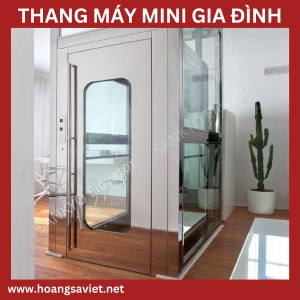The system is processing. Please wait a moment!
- Home experience homelift & elevator technical Sharing experiences
Elevator Classification Criteria
TABLE OF CONTENTS
Elevators , a vertical movement tool, have become indispensable in today's modern architecture. Integrating advanced technology, elevators not only ensure absolute safety but also meet all human mobility needs. Complying with state and organizational standards, modern elevators are a symbol of convenience and safety in today's society.
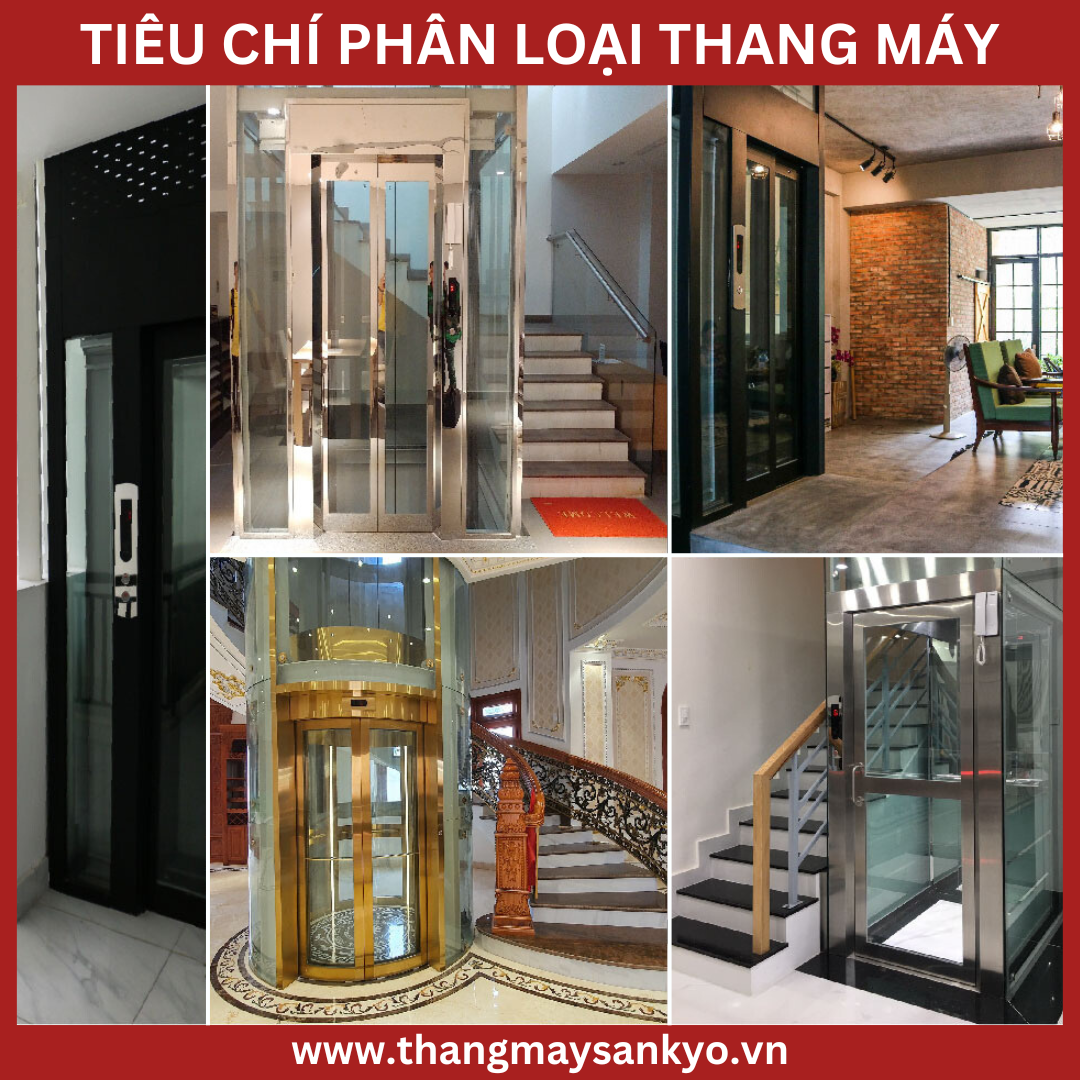
With a variety of designs and types, today's elevators are created to be flexible and suitable for all types of projects. Classifying elevators based on specific criteria helps optimize performance and integrate them effectively into every architectural project. We invite you to carefully study the criteria below with SANKYO Elevator !
SEE MORE OTHER PRODUCTS:
CLASSIFICATION OF COALG MACHINERY ACCORDING TO USE
Based on TCVN 7628-1:2007 standard on Elevator Installation , elevators are classified into 6 types depending on the criteria of usage. More specific:
Passenger Lift - Passenger Lift - Class I elevator
Passenger elevators are elevators designed to transport people in areas such as hotels, offices, motels, schools, and homes. The features of these elevators can vary widely in size, speed, and interior options, depending on the specific use of the elevator.
Freight Lift - Type II elevator
Elevators are built primarily to transport people, but are also optimized to handle goods accompanying the user. Commonly used in supermarkets, exhibition areas, and factories, this type of people and goods elevator is designed to meet the needs of moving both people and goods effectively.
Hospital elevator (patient elevator) - Type III elevator
This is an elevator specifically designed to transport hospital beds (stretchers), popular in hospitals, nursing homes and medical facilities. The hospital elevator cabin is designed with spacious dimensions to conveniently accommodate a stretcher or hospital bed, along with doctors, medical staff and related emergency equipment.
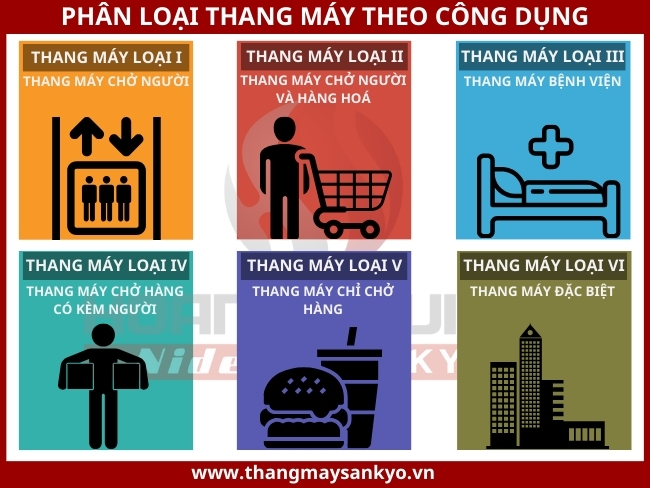
Accompanying freight elevators – Class IV elevators
Accompanying freight elevators are primarily designed to transport goods, but are often capable of carrying people. This type of ladder is popular in factories, workshops, warehouses and is also used in areas such as ladders for hotel staff. Although primarily intended for moving goods, these escorted freight elevators still provide the convenience of being accompanied for flexible travel needs.
Unaccompanied freight elevators (service elevators) – Type V elevators
Unaccompanied freight elevators of this series have the unique feature of having only a control panel outside the cabin, specifically for cargo transportation. This elevator's cabin is designed with controlled dimensions to ensure that no one can get inside. This elevator often appears in hotels, cafeterias or is used to move books in libraries and meet the needs of transporting goods effectively.
Special elevators - Type VI elevators
Elevators of this type have a starting speed of 2.5 m/s or more, often used for buildings with a number of floors greater than 15. This helps ensure quick and efficient movement in buildings. large-scale project.
CLASSIFICATION OF ELEVATORS ACCORDING TO TRANSMISSION TECHNOLOGY
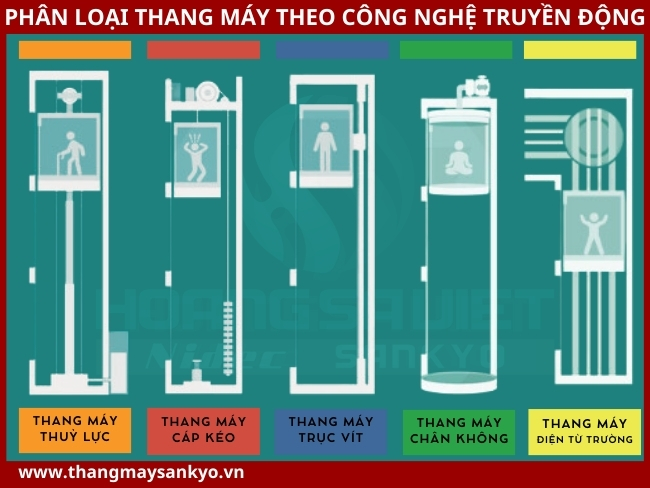
Elevator drive technology comparison table
|
Technology elevator |
Hydraulic elevator |
Cable elevators have machine rooms |
Cable elevators do not have a machine room |
Screw Elevator |
Vacuum Elevator |
|
Comparison criteria |
|||||
|
Optimal speed (m/s) |
0.3 - 0.6 |
≥ 1 |
0.15 - 0.3 |
0.15 |
|
|
Ratio of cabin area/elevator well |
60% |
30 - 40% |
70% |
99% |
|
|
Cruise height (m) |
17 - 25 (7 floors) |
Unlimited |
2256 ≤ 16 (≤ 4 floors) |
||
|
OH height (mm) |
2,250 - 2,600 |
3,300 (and engine room height ~ 1,800) |
2,700 - 3,400 |
2,000 |
2,400 |
|
Pit hole (mm) |
100 - 150 |
Minimum 600 |
Minimum 330 |
50 |
50 |
|
Smallest stairwell (mm) |
930 x 820 |
1200 x 1360 |
1150 x 1300 |
1020 x 980 |
|
|
Stability (dB) |
47 - 48 |
50 - 60 |
70 |
70 |
|
|
Guarantee (month) |
36 |
12 - 36 |
twelfth |
36 |
|
|
Advantage |
Super small, no noise |
Speed, height |
Save space |
Panoramic view, space saving |
|
|
Defect |
Limited speed and travel height |
Waste acreage |
- Speed, stability - Cruise height |
Cost, stability, ride height |
|
|
Safety features |
ARD, SRS, Emcall, CARe, SWS, SES,... |
ARD, Emcall |
ARD |
||
Note: The previous comparison table does not include electric field elevators, because this elevator line is not officially available on the commercial market, so missing technical specifications cannot be included.
Hydraulic elevator series
Hydraulic elevators are characterized by the cabin being pushed up from the bottom using hydraulic cylinders. An electric pump creates pressure by pushing hydraulic fluid into the cylinder, creating enough pressure to push the piston and move the cabin. This process helps hydraulic elevators operate safely and stably.
Current hydraulic elevators can operate with a maximum travel of about 27m, equivalent to the height of a 7-storey building. Because of limited travel, they are often not suitable for buildings with too many floors.
Therefore, hydraulic elevators are often used in low-rise buildings where the height is no more than 10 floors. Hydraulic elevators are also used in buildings with low loads, such as houses, hotels and restaurants...
Cable elevator line
Cable traction elevators are an advancement in elevator technology where car travel is controlled using a single or three-phase traction machine through the rotation of pulleys connected to cables. This type of elevator is classified based on the location of the driving machine, it can be a cable elevator with a machine room or a cable elevator without a machine room .
A cable elevator with a machine room is an elevator with a separate machine room design at the top of the elevator pit. The machine room is where the electrical cabinets, control cabinets, traction system and mechanical brakes are located. Machine roomless elevators are elevators without a separate machine room , the tractor is designed to be located on top of the cabin guide rail and counterweight, the electrical cabinets and control cabinets are located on the side of the top floor door. The mechanical brake is mounted on one side of the canbin guide rail. On the ceiling of the top of the elevator shaft, 2 construction hangers must also be designed. Ventilation holes must be designed for the tractor to cool down.
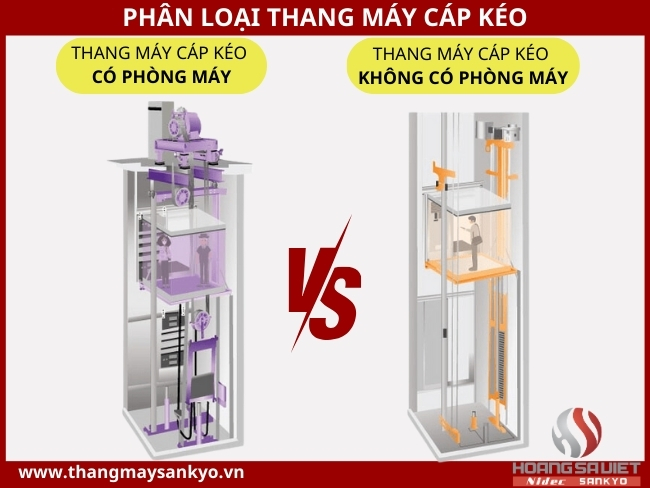
Cable elevators are often used in high-rise buildings, with a height of 10 floors or more. Cable elevators are also used in buildings with large loads, such as shopping malls, hospitals, and hotels.
Screw elevator series
The screw elevator series is a unique type of elevator, using the screw principle to move the cabin up and down during operation. Instead of using cables or chains, screw elevators have a screw that runs vertically through the cabin and rotates to make the move.
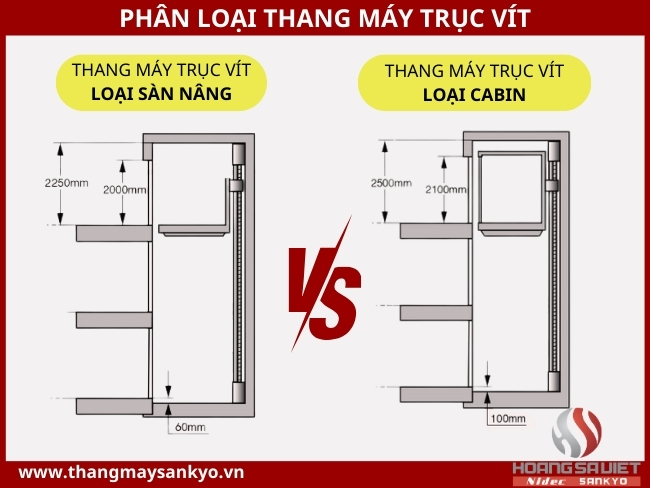
However, it should also be noted that screw elevators have limitations in carrying loads and are not suitable for applications requiring large loads or high-rise buildings. This makes them often used in specific situations and not the primary choice for large projects.
Vacuum elevator series
Vacuum elevators are unique compared to other types of elevators, especially in their drive and structure. Its driver consists of a vacuum pump and control valves located at the top of the guide column. In the guide column, there are guide rails to shape the movement of the cabin up and down.
The roof and ceiling of the vacuum elevator cabin are discreetly designed with guide posts, functioning as a type of pneumatic piston.
This type of vacuum elevator is flexible in installation without requiring a stairwell, and can be placed right on the balcony by creating a hole through the floor for the guiding pillar to pass through. However, for practical applications, it is not yet popular because of the limited number of stops (maximum 4 stops), low load capacity (about 110kg to 240kg) and low travel speed.
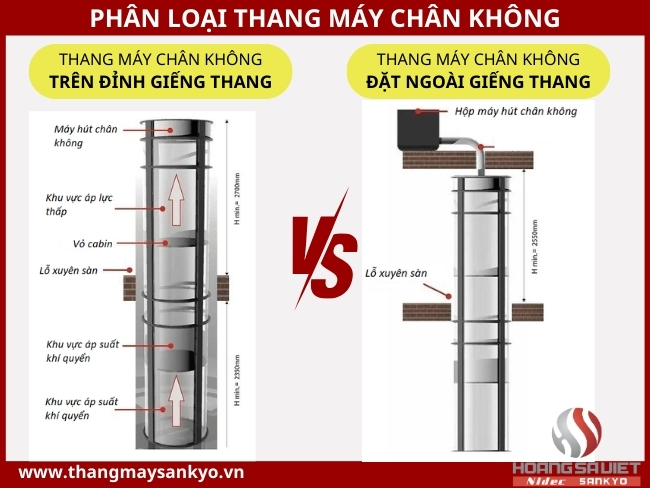
Electromagnetic elevator series
Mr. Andreas Schierenbeck , CEO of Thyssenkrupp Elevator Company , said: " This is the first elevator system that operates without cables, the elevator not only goes up and down but can also move left or right. This maglev elevator system can have more cabins ".
This new electromagnetic elevator system promises to cut down on the amount of time people spend waiting and traveling in elevators. The secret to this system lies in its ability to move without the constraints of traditional dual cables. Instead, this elevator uses a linear induction motor, built on a flat core with coils that transmit electric current, creating a moving magnetic field. What's special is that this engine is capable of pushing many different cabin systems through a single shaft, designed in a loop form to flexibly move both vertically, horizontally and diagonally.
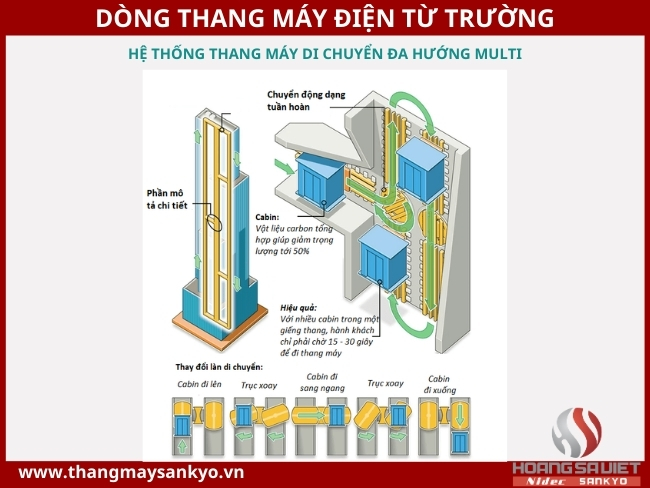
The ideal height for deploying the Multi elevator system is 300m, but is capable of being used for smaller projects. What's special is that, because the system does not use cables, it does not require elevator compartments to be built vertically. Thanks to the ability to place multiple cabins in the same compartment, the system also helps optimize space and reduce travel time in the building.
This new elevator model is significantly lighter than other elevators, thanks to its carbon composite construction and the complete elimination of cables. However, although it has been experimentally installed on three shafts at a 246m high tower in Rottweil, Germany since 2017, this elevator line has not yet been officially introduced into the commercial market by ThyssenKrupp.
SEE MORE OTHER PRODUCTS:
CLASSIFICATION OF ELEVATORS ACCORDING TO MACHINE ROOM LOCATION
Below is a table classifying elevators according to the location of the driving machine:
|
Elevator Type |
Location of Drive Machine |
|
Elevator with Machine Room (Machine Room – MR) |
- Place at the top of the stair well or next to the well. - Can be placed on any floor in the building. - The driving machine is usually located in a separate room. |
|
Elevator Without Machine Room (Machine Roomless – MRL) |
- Place directly in the elevator pit. - The driving machine can be above or below the elevator pit. - Does not require a separate engine room. |
CLASSIFICATION OF ELEVATORS ACCORDING TO ORIGIN
Elevators are manufactured domestically
According to TCVN 5744:1993 on elevators - Safety requirements in installation and use, regulations on installation conditions for domestically manufactured elevators are as follows:
1. Elevators are manufactured by units that have legal status and have been permitted by competent authorities.
2. Elevators must be manufactured in accordance with current technical standards and must comply with the provisions of this standard.
3. Mass-produced elevators must comply with tested samples and must have complete original technical documents.
4. Important parts and details that cannot be manufactured and must be imported or jointly manufactured must clearly state basic parameters and technical specifications in the dossier.
Domestic elevators are products registered by Vietnamese businesses and operating in the field of elevator production and manufacturing. To bring this product to market, elevator models must meet quality standards and current technical regulations. Important parts and details, if they cannot be produced domestically, need to be imported or jointly manufactured, with clear basic parameters and technical specifications in the documents.
In fact, most important parts such as motors, control cabinets, cables, guide rails, etc. still have to be imported, then combined with details and equipment produced by domestic enterprises. Okay.
There is a frequent misunderstanding when many people think that domestically manufactured elevators are joint venture elevators , due to confusion in definitions and product introductions. However, these are two completely different concepts.
Joint-venture elevators are products with core technology, original designs, and investment in research and calculation of physical, chemical factors, etc. in a comprehensive way to combine the details in a comprehensive way. Useful and safe. More importantly, the connection and cooperation between the parties is built on a legal basis.
Imported elevator
According to TCVN 5744:1993 on elevators - Safety requirements in installation and use, regulations on conditions for installing imported elevators include:
1. Must have original technical documents.
2. Elevators must be manufactured according to international standards or national standards of the place of manufacture and must comply with Vietnam's safety standards.
3. The accompanying machine parts must be synchronized or, if manufactured in a coordinated manner from multiple manufacturers or countries, must ensure technical specifications according to the responsible elevator company. Particularly important are the technical specifications of important parts and details such as steel cables, load-bearing chains, guide rails for the cabin and counterweights, drive pulleys, guides, and correct floor control brake system. , safety braking system, safety control mechanisms, and protection signals.
Imported elevators are products of international brands, imported to Vietnam in intact form. They are manufactured according to international or national standards of manufacture. When imported and installed in Vietnam, this elevator must comply with domestic safety standards.
According to QCVN 02:2019/BLDTBXH on Labor Safety for Elevators, both domestically manufactured elevators and imported elevators must be inspected and tested for safety components and equipment, including safety equipment. landing door lock and cabin door lock (if any), safety brake, drive brake system, overspeed controller, damper and shut-off valve/one-way valve.
In short, depending on the needs and specific conditions of each project, users have the ability to choose the most suitable type of elevator. Elevators are designed to meet a variety of purposes and requirements, from transporting people and goods to use in special projects such as hospitals or factories. For more detailed information and 24/7 free consulting support, you can immediately contact us - SANKYO Elevator to get your questions answered as quickly as possible and choose the right product for your needs. your.
“Hoang Sa Viet Elevator - Always with you on every high floor!”
HOANG SA VIET ELEVATOR - LEADING PRESTIGIOUS ELEVATOR COMPANY IN VIETNAM
Consulting Specialist: 0942.222.075 Head Office: 184/20 Le Dinh Can, Tan Tao Ward, City. HCM Hanoi headquarters: No. 229, D. Van Tri, Van Noi, Dong Anh, Hanoi Website: thangmaysankyo.vn Email: hungpham@hoangsaviet.com



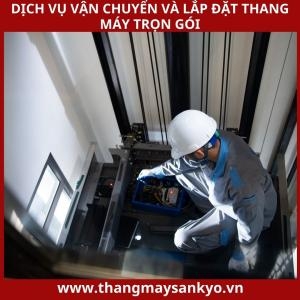
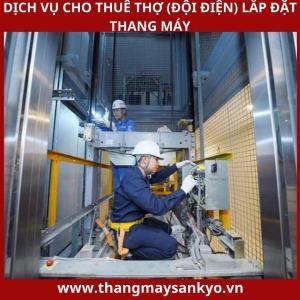
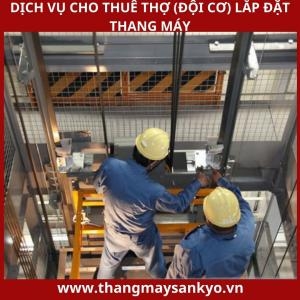

.png)
.png)

.png)






